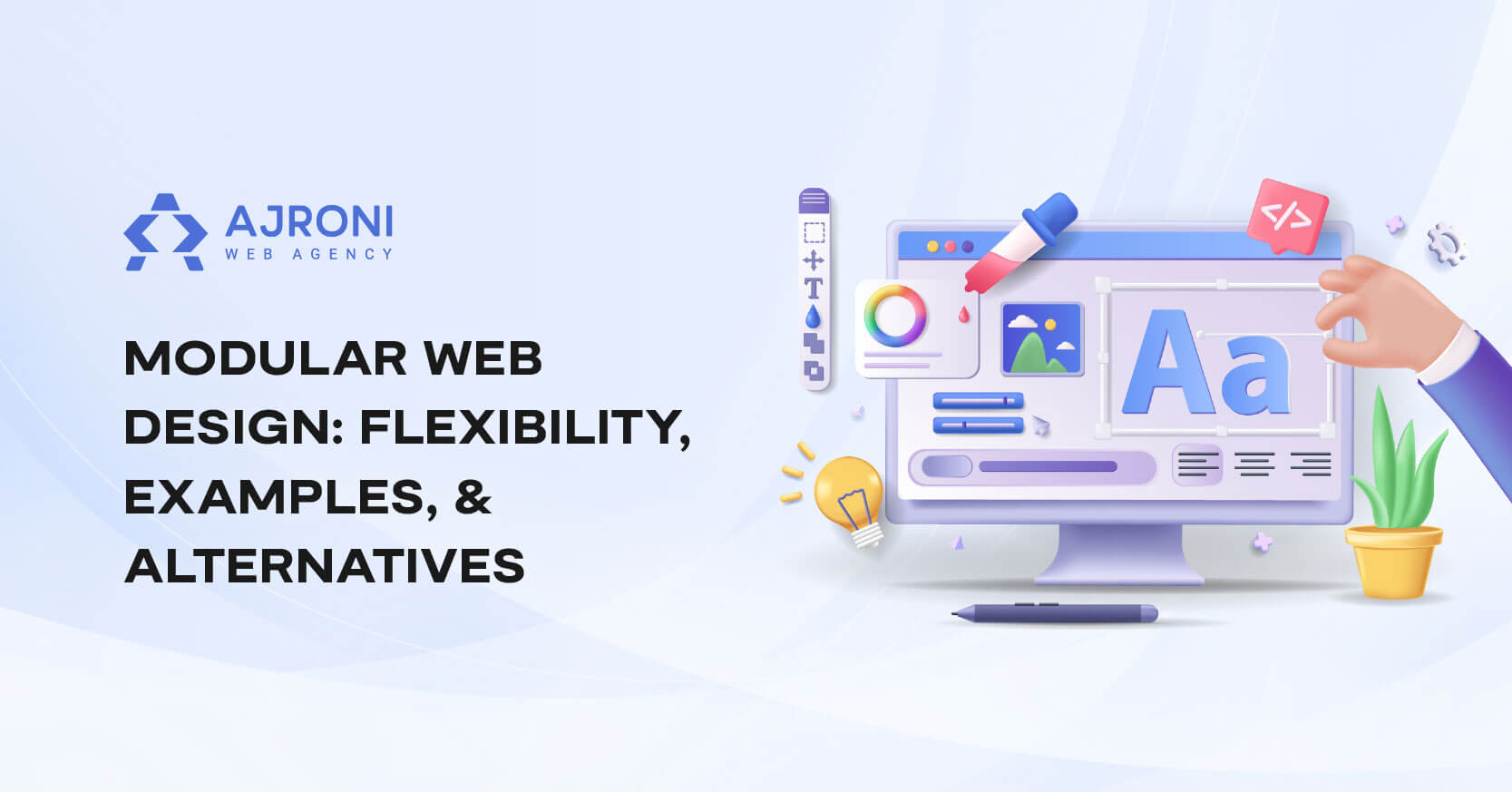Modular web design is a modern approach to creating websites by reusing components, allowing faster development and an improved user experience.
Modular Web Design: Flexibility, Examples, & Alternatives [2023]
If you ever thought about building your website without having to go through complicated developing processes, modular web design is the solution!
Imagine this; you have hundreds of puzzles you need to merge in front of you. These pieces may seem random at first, but with a dose of creativity, you can turn them into something beautiful.
This is how modular web design works. You have to break down the website into small, reusable components and then assemble them together to create a visually pleasing website.
Each piece has its own function and purpose, but together, they form a bigger and more complex structure. The only difference is that with modular web design, the possibilities are endless.
What is Modular Design?
If you’ve heard of website builders like Squarespace and Wix before, you probably know what we are talking about. Modular web design is an innovative and modern approach that helps you build websites by designing their components separately.
By making changes and designing them piece by piece, you can create your website exactly how you want it. Not only does it improve the user experience by giving them access to an easy-to-use standard interface, but it can also improve the loading speed of a website by up to 15%. With this model, everyone can build websites without having to hire developers and spend money on something they can easily do themselves.
This interesting design approach is already leaving a mark in the web design industry and is expected to expand even more in the future.
Modular Design’s Impact on the Future of Website Building
There’s no doubt that modular design has already impacted and improved the web design industry, but we will let statistics speak for themselves:
- 80% of web developers believe that modular website design is the best approach for creating a successful website.
- 65% of businesses that use modular website design find it easier to make website changes.
- Modular web design can improve a website’s user experience by up to 30%.
Modular Designs = Endless Alternatives
It seems like modular web design is here to stay, and it is easy to see why. Among the many advantages it offers users, we have selected the top 5 reasons we like this approach.
Flexibility
Do you want to change or update a sector on your website? No need to rebuild the entire design; all you have to do is directly change the modular component you want. As simple as that!
Reusability
Modular components can be reused across different pages and sections, making the web development process even simpler. You can always experiment and try new strategies until you’re happy with the final results.
Scalability
Because modular components can be easily rearranged, the website can adapt to different screen sizes and resolutions. This means the website is responsive and visitors can check it from any device.
Maintainability
Because of the separation of concerns, the codebase is maintainable and less predisposed to errors; this way is more efficient to fix issues if there are any.
Cost-effectiveness
Modular web design is more cost-effective than traditional design methods because it requires fewer resources for updates and maintenance.
How Modular Web Design is Implemented
Now that you are familiar with the definition of modular web design, here are the basic steps to implement it.
Define the Structure
First, think of how you want your website to look and the message you aim to convey. After having a clear idea, identify the elements that will make it up, such as the header, footer, and main content area. These elements are called the building blocks of the website.
Create the Components
Using the development framework or module library, you can create components for each element identified in step 1.
Assemble the Components
Here comes the fun and creative part. Gather all the individual components to create new pages and sections. Together they will build a functional, well-structured, and appealing website.
Add Interactions and Functionality
This includes buttons, forms, or data displays. For example, you can add a read more or contact us button to simulate user interaction.
Test and Debug
Test the website and debug issues if there are any. Since no coding is needed, the design and development processes are more efficient and less prone to errors.
Optimize and Maintain
Optimize the website’s performance and make changes when needed. Remember, website maintenance in a modular product is as important as its design.
Where to Build a Modular Web Design?
The secret is out! Here are our favorite tools for building a modular web design.
Website Builders
Let’s start with the self-explanatory ones. Website builders such as Wix or Squarespace provide many pre-built modules to create a website. These website builders do not require advanced technical expertise and are easy to use. The only challenge is that they may offer less flexibility over the site’s functionality and appearance.
Custom Development
A simple way to build a website from scratch is by using a development framework or library that supports modular design. This requires some technical expertise, but on the other hand, it gives more control over the design and functionality of the site.
Headless CMS
Use a headless CMS (Content Management System) to manage the content, and then use a framework to build the frontend. This cost-effective development maintains a high degree of control over the website.
Customizable Templates
Using customizable templates from platforms such as ThemeForest is a good option for developers with technical skills but not enough to start from scratch.
Challenges of Modular Web Design
As with everything else, modular web design has its own challenges.
Here are a few examples:
Complexity
Modular web design can be complex, especially if you want to build a large or advanced website.
Overuse of Components
Even a website needs its dose of uniqueness. If you overuse the components, the website will look repetitive and monotonous.
Lack of Flexibility
In some cases, the modular approach can limit design flexibility, making it challenging to create unique and custom designs.
Difficulty in Integrating With Other Systems
Modular design can make it difficult to integrate with other methods, such as existing content management systems or APIs.
Lack of Design Consistency
Without a proper design system in place, the design of a website built with modular web design can become inconsistent over time.
Modular Design Websites Examples
Here are three examples of websites that have implemented modular design.
Résidence Mixte
Creative minds will love exploring this website, where all the elements blend together in an aesthetically-pleasing modular grid design. The way content is displayed is interesting and offers a unique user experience.
Everlovin
Have a look at Everlovin’s website to explore how modular components are arranged in a grid-style layout. You can find some creative inspiration simply by scrolling through this website!
MAP
MAP has taken blogging to the next level with its modern and magazine-inspired approach. It immediately draws visitors’ eyes to featured images- a thoughtfully curated gallery that looks both striking and haphazard in equal measure.
FAQs
1. What makes modular web design different from other web design approaches?
Modular web design is different from other web design approaches in several aspects. One of the main differences is that it gives users complete freedom to manage and design their own websites.
Components can be arranged in diverse combinations to create web pages and sections, making it an even more user friendly alternative to website design.
Another difference is that modular web design promotes consistency across a website, so users can easily navigate and understand the site’s layout.
In contrast, traditional web design approaches often involve creating a unique design for each website page, which can be more time-consuming and costly.
2. What are the benefits of modular web design?
Some of the benefits of modular web design summarized are:
- Reusable components
- Greater flexibility
- Better maintainability and adaptability
- Consistency across a website
- Cost-effective development process.
Modular web design offers a flexible and efficient development process by allowing users to use pre-built components and a standardized design system. This is a major benefit for developers who can focus on functionality rather than creating new design elements every time.
3. What tools are needed to create a successful modular web design?
- 1. Development Framework or Library: A development framework, such as React, Vue, Angular, etc., supports modular design.
- 2. Code Editor: A code editor such as Visual Studio Code helps write and edit the code for the website’s components and modules.
- 3. CSS preprocessors: These organize and maintain the styles of the website’s components.
- 4. Build tools: Build tools such as webpack or gulp to bundle and optimize the code for the website.
- 5. Version control: These systems track the changes in the codebase and work with other developers.
- 6. Design System: A set of design principles and components that help create a consistent and coherent visual language for a website.
- 7. Browser Developer Tools: browser developer tools such as Chrome DevTools, or Safari Web Inspector can debug and test the website in different browsers and devices.
4. How can I incorporate modular web design into my existing website?
Break down the website into smaller components and then recognize the codebase accordingly. After identifying and building the foundation elements of the website, you must create a modular system that guides its development. This design system should include design principles that help to create a consistent and coherent visual language for the website. Once you’ve identified the components, it’s time to reorganize the codebase to reflect the modular structure. This may involve refactoring existing code and ensuring that all the components are properly integrated.
5. What are the best practices when using modular web design?
- 1. Use a consistent layout across all modules.
- 2. Make sure modules are integrated into different parts of the website.
- 3. Use clear class and id names to make the modules understandable.
- 4. Use CSS preprocessors to keep the CSS organized and maintainable.
- 5. Check that the modules are consistent with the website’s overall design.
- 6. Test modules with different devices to ensure they are responsive.
- 7. Keep the modules independent to make them easy to update.
- 8. Use a version control system to manage the changes made to the modules.
- 9. Make sure the modules are accessible to users by following web accessibility guidelines.
Final Notes
A website you can easily arrange, modify and update? Yes, please!
Modular web design has already conquered the world of web design, and we can see why. The flexibility and convenience it offers are not to be underestimated. Now everyone can build their own websites within a few days, or probably even hours!
If you’re interested in similar topics, you can read our previous articles:
https://ajroni.com/best-law-firm-websites
https://ajroni.com/best-therapy-websites
https://ajroni.com/best-saas-websites
https://ajroni.com/best-dentist-websites-2022
https://ajroni.com/best-b2b-websites
https://ajroni.com/best-interior-design-websites




